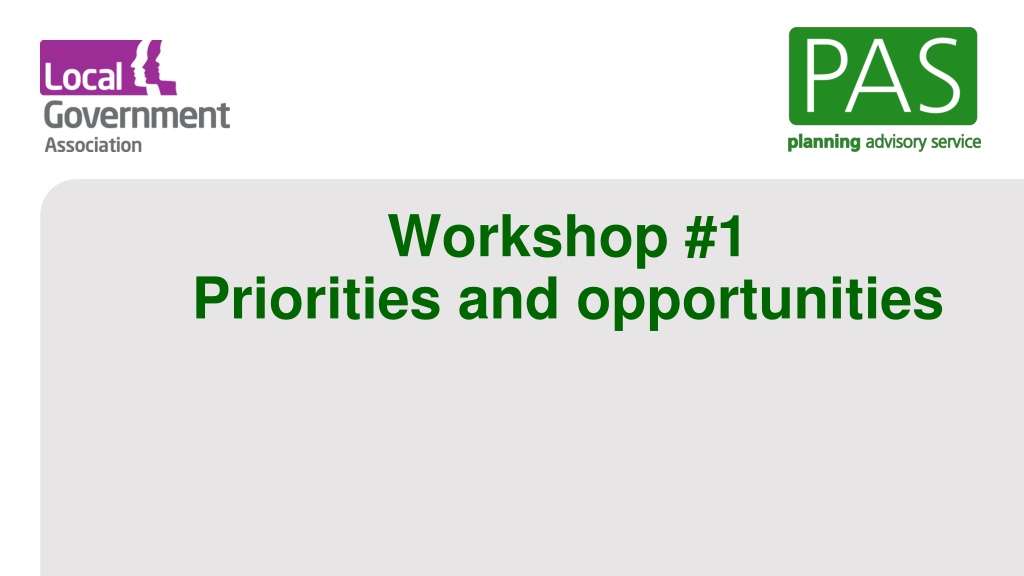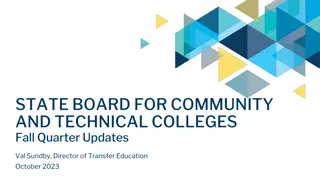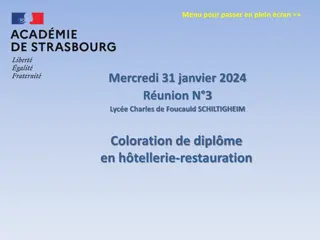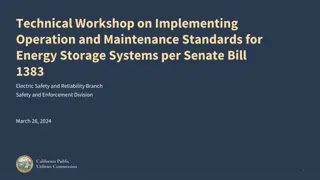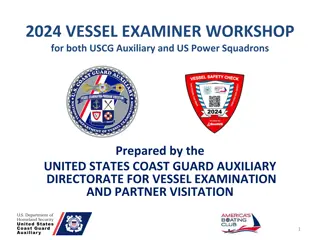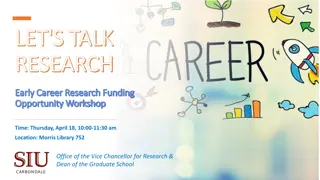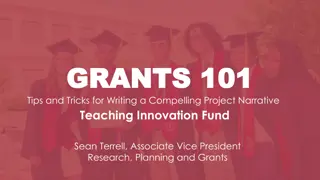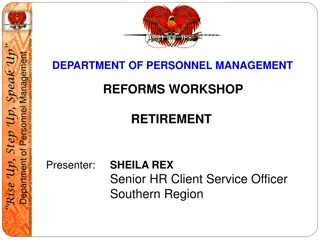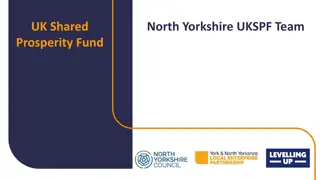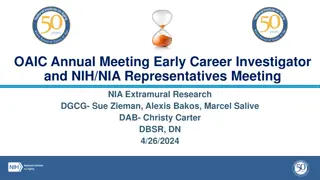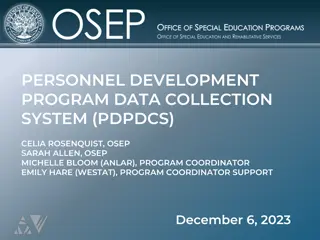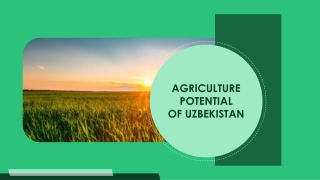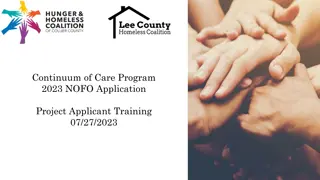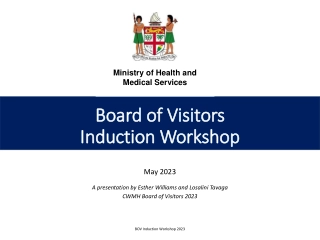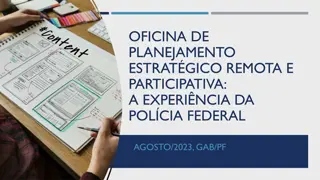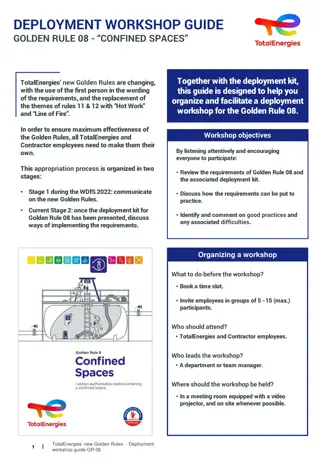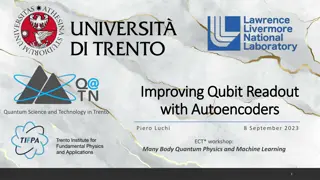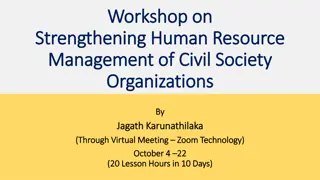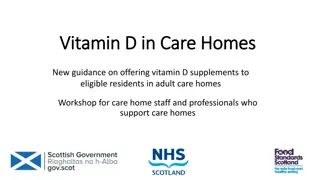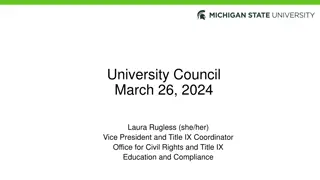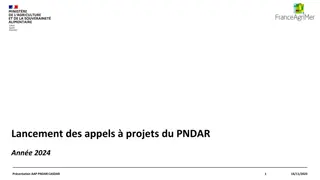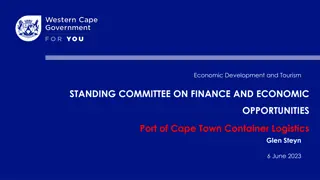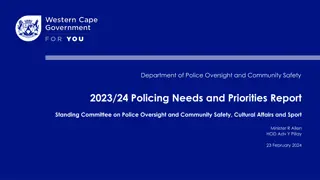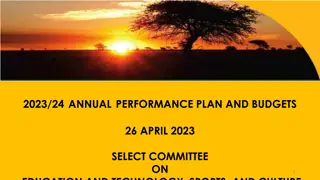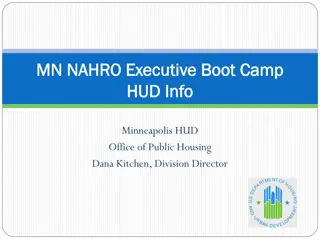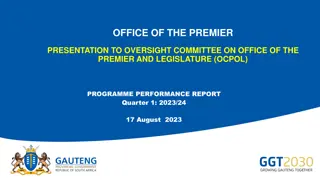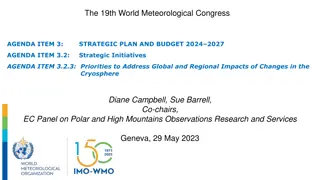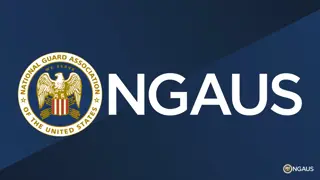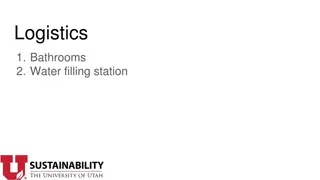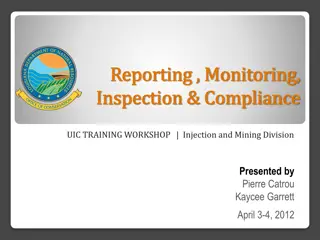Priorities and Opportunities Workshop Overview
Explore key priorities and opportunities in a workshop setting focusing on nature recovery reforms, council challenges, and interventions. Engage in discussions and breakout sessions to identify actionable steps to support council objectives through the Nature Recovery Toolkit.
Download Presentation
Please find below an Image/Link to download the presentation.
The content on the website is provided AS IS for your information and personal use only. It may not be sold, licensed, or shared on other websites without obtaining consent from the author. Download presentation by click this link. If you encounter any issues during the download, it is possible that the publisher has removed the file from their server.
Presentation Transcript
Workshop #1 Priorities and opportunities
Welcome, housekeeping, introductions
Agenda Welcome, housekeeping and introductions. Introduction to the toolkit and the workshop. Scene setting: What are the council s key priorities and challenges? How can nature and the government s nature recovery reforms help address these? What are the opportunities and types of interventions being delivered? Discussion: What does all this mean for your service and priorities? Break out session: Identifying what more can you do
Roles TBC Timekeeping, introduction and review TBC Workshop deepdives TBC Notetaking and reporting back on key issues TBC Flipchart scribe TBC Car park
and who are you? Introduce yourself to the group: Your name, where are you from and what do you do? Why are you interested in the toolkit and how could it help support your work?
Introduction Why are we here and what is this all about? Toolkit overview Objectives for the day (go through, then revisit at the end)
Nature Recovery Toolkit Help councils understand a complex world by providing: A framework for: Supporting corporate objectives through the new duties including BNG, Biodiversity Reporting and LNRS Understanding the statutory (must do s) and opportunities (could/should do s) Deciding what to do (who contributes, objectives, the evidence base, funding, making it happen etc) Getting local authorities interested Workshop template Priorities and opportunities Barriers and solutions Funding and delivery Slidedecks and briefing notes Appendices Action template - council activities, assets and responsibilities Useful data layers Key headlines Priority steps and checklist Pre work and inception meeting Design and deliver 3 x workshops Useful workshop outputs and relationships Ideas to take forward A process: Engaging the right stakeholders Working with stakeholders to decide what to do Understanding the oversight and governance requirements for your chosen priorities
Toolkit products Workshop planning template (Design 3 x workshops and exercises) Challenges and opportunities Barriers and solutions Funding and delivery Slidedecks Briefing notes Recordings Supporting resources Action template - council activities, assets & responsibilities Useful data layers and key headlines which can be used to inform conversations Appendices
Objectives for Workshop #1 Purpose: To understand what nature and the governments nature recovery reforms mean for your council, what action it is already taking and what else could it do to take full advantage of these new opportunities? Output: List of immediate opportunities identified to be explored in more detail as part of Workshop #2
Testing the objectives Scene setting Group discussion Break out groups
All clear and ready to move on? Is everyone clear on why we are here today? Is everyone clear on whose doing what and their roles today? Is there anything fundamental that we may have missed? Does anyone have any burning questions they want to raise now?
Thank you Email pas@local.gov.uk Web www.local.gov.uk/pas Phone 020 7664 3000 Twitter @Pas_Team
Scene setting What are the council s key priorities and challenges? How can nature and the government s nature recovery reforms help address these? What are the opportunities and types of interventions being delivered?
Council priorities and challenges What are the council s key challenges and priorities? We are also facing a climate and biodiversity emergency What are the environmental impacts affecting service delivery? How are you linking policy agendas together?
Key challenges and priorities Spending cuts Economic uncertainty Increasing prosperity Strengthening communities Improving the environment Protecting the vulnerable Climate change Welfare reform Youth unemployment Housing need Aging population
We are also facing a twin crises! We are facing twin crises - an ecological crisis that is exacerbated by, and exacerbates, the climate crisis. Along with the transformative changes needed to tackle climate change and deliver Net Zero, transformative change is also needed to deliver Nature Recovery and this requires a mind-set shift for national government and local authorities. Addressing both together is a win win! Source: UK100
Environmental impacts affecting assets & services Changing temperatures Flooding Air and water quality Biodiversity decline Access to good quality green space
Linking policy agendas together Supporting housing development Sustainable transport Better health and well being Ensuring climate change adaptation and mitigation Reducing flood risk Improving air and water quality Thriving biodiversity including the pollinators on which we all depend Source: UK100
How can nature and the governments nature recovery reforms help address these? How can nature help? Valuing the benefits from nature Legislative and policy requirements Environment Act 2021
How can nature help? Our economies, livelihoods and well-being all depend on our most precious asset: Nature Dasgupta Review (2021): Healthier, more resilient Nature Healthier, more resilient Places Healthier, more resilient People Healthier, more resilient Economy
Whats the scale of the problem? Climate and biodiversity crises UK is bottom 10% globally and worst G7 nation for biodiversity loss. Nature is key to mitigating and adapting to climate change, and supporting health and wellbeing. Health crisis: Annual loss to economy with mental health absence from est. 70 - 100bn. Approach over past 70 years focus on nature conservation: preserving pockets of nature. Hasn t stopped decline need to move towards nature restoration and nature recovery State of Nature 2023, the State of Nature partnership, Available at: www.stateofnature.org.uk
Legislative and policy requirements Lawton Report Make Space for Nature (2010) - Bigger, Better, More Joined up 25 Year Environment Plan (2018) - Be the first generation to leave the environment in a better state than we found it . Develop a Nature Recovery Network NPPF updates Levelling Up and Regeneration Bill Agriculture Act (2020) public money for public goods Environment Act (2021) species and habitat targets, mandatory 10% BNG for developments, LNRS 30 by 30 Pledge (2020) protect 30% of land/sea by 2030 Land Use Framework? Environmental Improvement Plan (2023) - builds on 25 Year Environment Plan and Environment Act 2021. Green Infrastructure Framework (2023) voluntary 40% green cover in urban residential areas; 15 minutes to nature
Environment Act 2021 Responsible authorities appointed by the Secretary of State (S105) to lead the Local Nature Recovery Strategy (LNRS), working with a broad range of stakeholders. Enhanced duty for LAs to conserve and enhance biodiversity (S102) and report on their actions (S103) LPAs will need to comply with the above duty and have regard to the Local Nature Recovery Strategy in local planning policy and decisions (S102). All planning permissions granted in England (with a few exemptions) will have to deliver at least 10% biodiversity net gain from Nov 2023 (S98-101)
Mandatory Biodiversity Net Gain England only and covers all (bar exempted) development under the Town & Country Planning Act (TCPA) majors now, non- majors from 2 April - and (from 2025) 2008 Planning Act, i.e. NSIPs Minimum 10% gain required and post- planning approval of biodiversity gain plan Significant on-site and off-site habitat secured for at least 30 years BNG hierarchy: on-site, off-site and last resort statutory biodiversity credits Baseline and post-intervention unit values calculated using standardised biodiversity metric National register for off-site net gain sites
A strengthened biodiversity duty Public authorities who operate in England must consider what they can do to conserve and enhance biodiversity in England. This is the strengthened biodiversity duty that the Environment Act 2021 introduces. This means that, as a public authority, you must: Consider what you can do to conserve and enhance biodiversity. Agree policies and specific objectives based on your consideration. Act to deliver your policies and achieve your objectives.
Local Nature Recovery Strategies Local Nature Recovery Strategy Opportunities map (source Greater Manchester LNRS pilot) New system of locally led, transparent and collaborative spatial strategies for nature s recovery covering the whole of England. Each of the LNRS will be led by a responsible authority who are preparing them over the next 12-13 months, following regulations and guidance Each strategy will: Map the existing areas designated for biodiversity Agree priorities for nature recovery Map actions for delivering priorities in areas where they provide the best environmental outcomes Local delivery will be through a variety of mechanisms including Biodiversity Net Gain and Environmental Land Management schemes.
Green Infrastructure Framework Green Infrastructure Standards National standards for green infrastructure quantity and quality. What is the Green Infrastructure Framework? The Green Infrastructure Framework supports the greening of our towns and cities as part of the Nature Recovery Network. It sets out what good looks like for local planning authorities, developers, parks and greenspace managers and communities. It provides tools to help plan and design green infrastructure networks that deliver multiple benefits. The five main products in the Framework are: Green Infrastructure Principles Why, What and How of good green infrastructure Green Infrastructure Mapping Mapped datasets to support the standards Planning and Design Guide How to design good quality green infrastructure Why: 1. Nature 2. Health 3. Economy 4. Water 5. Climate What: 1. Multifunctional 2. Varied 3. Connected 4. Accessible 5. Responds to Character How: 1. Partnership and Vision 2. Evidence 3. Plan Strategically 4. Design 5. Manage, Value and Evaluate Process Journeys How to apply the products in the Framework- Planners, Developers and Neighbourhood Planners For more information scan the QR code or copy the link: https://designatedsites.naturalengland.org.uk/GreenInfrastructure/Home.aspx
What is your council doing now to take full advantage of the new duties and requirements?
An A-Z of quick wins A - Use suppliers that have an ethical mission/framework. P - Identify opportunities for habitat creation. Q - Recognize and promote the health and wellbeing benefits of nature-rich places. R - The value of holistic NHS delivery, through social prescribing, volunteering in green spaces, supporting community gardens. S - Provide Nature/Biodiversity/climate courses at Sutton College. T - Invest in local initiatives to reduce food miles and support local employment/expertise in food growing (e.g., Sutton Community Farm, ICR herb growing, High Down horticulture skills). U - Ensure Nature's services are recognized as critical infrastructure in new development. V - Be familiar with terms such as Nature-Based Solutions, Natural Capital, Biodiversity Net Gain, and what they mean to your service. W - Write/approve policy, provide maps and tools to guide developers to see nature as essential/added value. X - Implement a Kerbside Strategy - to get more nature-greening along roads and encourage active travel. Y - When attenuation tanks are proposed, ask for further justification - green roofs and rain gardens should be the first choice. Z - Think outside your role or service, help colleagues across the council. B - Audit carbon/biodiversity offsetting claimed by third-party firms (avoid 'greenwashing'). C - Train new staff on nature-based solutions. D - Audit projects that directly impact habitats/vegetation. E - Assess impact of borough-wide procurement of products and services (e.g., lighting). F - Check pension provider supports ethical investment. G - Source food locally, avoiding palm oil. H - Avoid peat-based products. I - Identify mono-culture/single-use decisions/outcomes and explore if a multi functional approach could deliver better outcomes. J - Design for bio-solar roofs rather than only solar. K - Understand the council's policy of 60% native planting schemes. L - Help people benefit from nature through increased direct experience. M - Require an understanding of the climate and ecological crisis and evidence of personal action through the recruitment process. N - Share best practice across teams. O - Understand the biodiversity value of your assets/under your control. Source: Sutton Council
Corporate committments Source: Dorset County Council
Changing maintenance regimes Source: Dorset County Council
School raingardens Source: The BITC Water Taskforce Water Resilient Cities project
Resilient highways Source: Arup
Carbon storage on estates Source: Hampshire County Council
Thank you Email pas@local.gov.uk Web www.local.gov.uk/pas Phone 020 7664 3000 Twitter @Pas_Team
Discussion What does all this this mean for your services and priorities?
Key questions to address What are your service priorities and objectives? What are the economic, environmental and social challenges affecting delivery? How can nature and the government s nature recovery reforms help address these? What are the risks of doing nothing?
Break out session Split into groups and use the first part of the action template in the next slide to map out: What opportunities are you currently delivering? Challenges - What are the challenges affecting delivery? Strengths - What are you doing well to address these? Needs - What would you like to do better? Opportunities - What can you do to improve and how? Use the checklists and template to help inform the process. From the discussions what are the immediate opportunities you would like to consider further as part of Workshop #2?
Priorities & opportunities template Service Status quo Strengths Weaknesses Opportunities Education Environmental health Estates Finance Health and social care Highways Housing Leisure and recreation Planning Transport Waste
First part of the template Service Priorities & Opportunities Barriers & Solutions Funding & delivery Status quo Strengths Weaknesses Opportunities Outcomes Barriers Solutions Partners Why What How How much What projects and activities are you currently delivering? What has worked well? What could be improved/what more could you do? Outcomes - What are the types of outcomes your looking at delivering? How can these barriers be addressed? Who else do you need to work with internally and externally? Why are you taking your opportunity forwards? What is the project and/or activity involved? How will it be delivered and by whom? How much will it cost and does it stand up financially? What hasn t worked well? What s stopping you from delivering the opportunities? Economic regeneration Education Environmental health Estates Finance Health and social care Highways Housing Leisure and recreation Planning Transport Waste
Now (Yellow notes) Capture what you are doing now: Existing examples Reinventing the wheel is OK. Practice that is low risk, high acceptability and easy to implement. Solutions to fill existing gaps in processes. Focus on incremental benefits. Strengths (Green notes) Capture whats worked well: Innovative breakthrough ideas. Practice that has high impact. Practice that is relatively easy to implement. Wow ideas are those with potential for significant change and possible to implement within current reality. Weaknesses (Pink notes) Capture whats not worked well: What currently challenges the Now ? What risks are there to achieving the ambitions? What practice is currently impossible to implement (what are we waiting for and need to know?) Opportunities (Orange notes) For each orange note capture what could be improved and/or what more could you do: What is within the councils discretion? How can you reduce the risk? What could government do to help? What can you do better? What can you stop doing? Remember each opportunity however big or small adds to the understanding of what is possible.
Feedback and review Each group presents back on what they have discussed and the immediate opportunities identified. All to discuss and agree on a short list of immediate opportunities to be explored in more detail as part of Session 2.
For more information Environment Act 2021 Environmental Improvement Plan 2023 Understanding biodiversity net gain Defra Complying with the biodiversity duty Natural England s Green Infrastructure Framework PAS Environment webpages UK100 Powers in Place: Nature Report UKGBC Nature Recovery and Climate Resilience Playbook Nature Scotland Nature Based Solutions for Local Authorities
Thank you Email pas@local.gov.uk Web www.local.gov.uk/pas Phone 020 7664 3000 Twitter @Pas_Team
